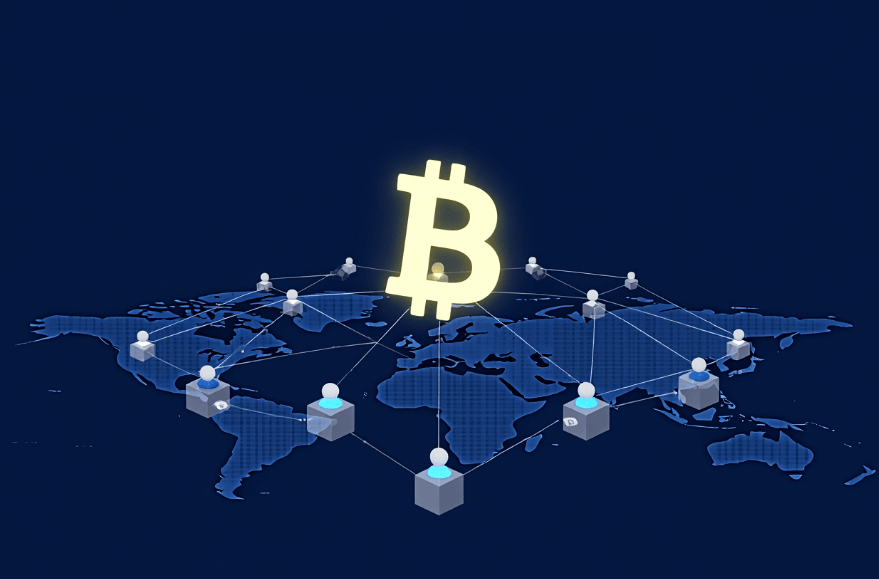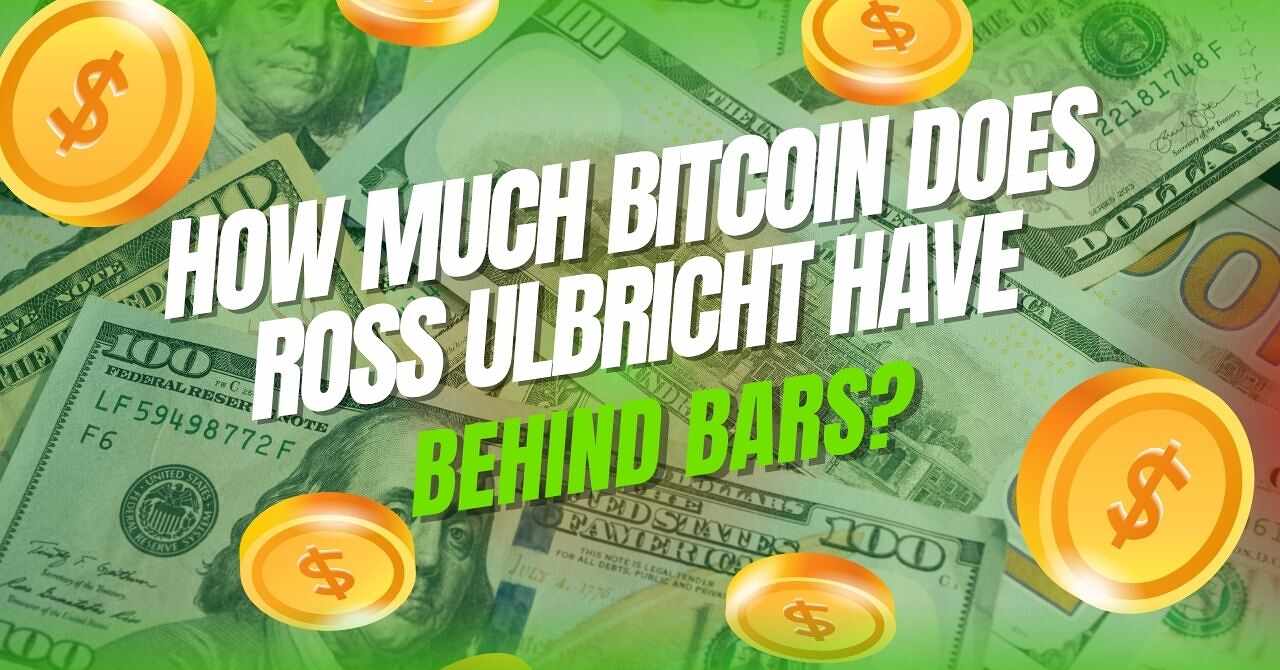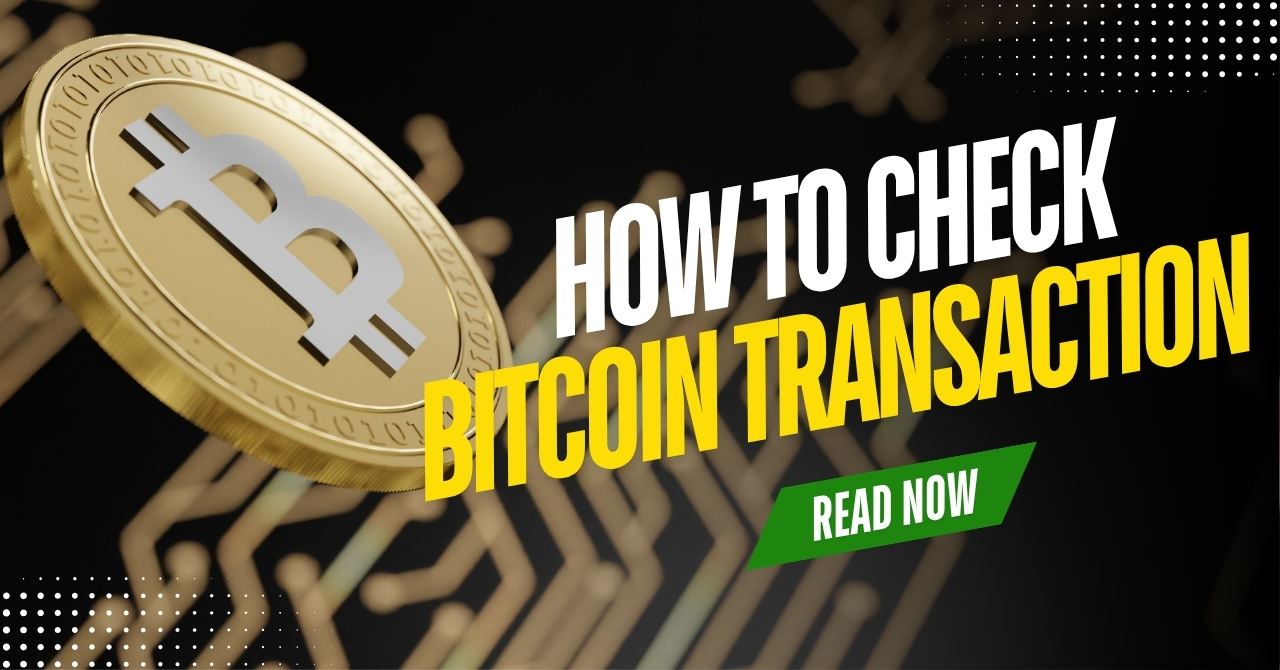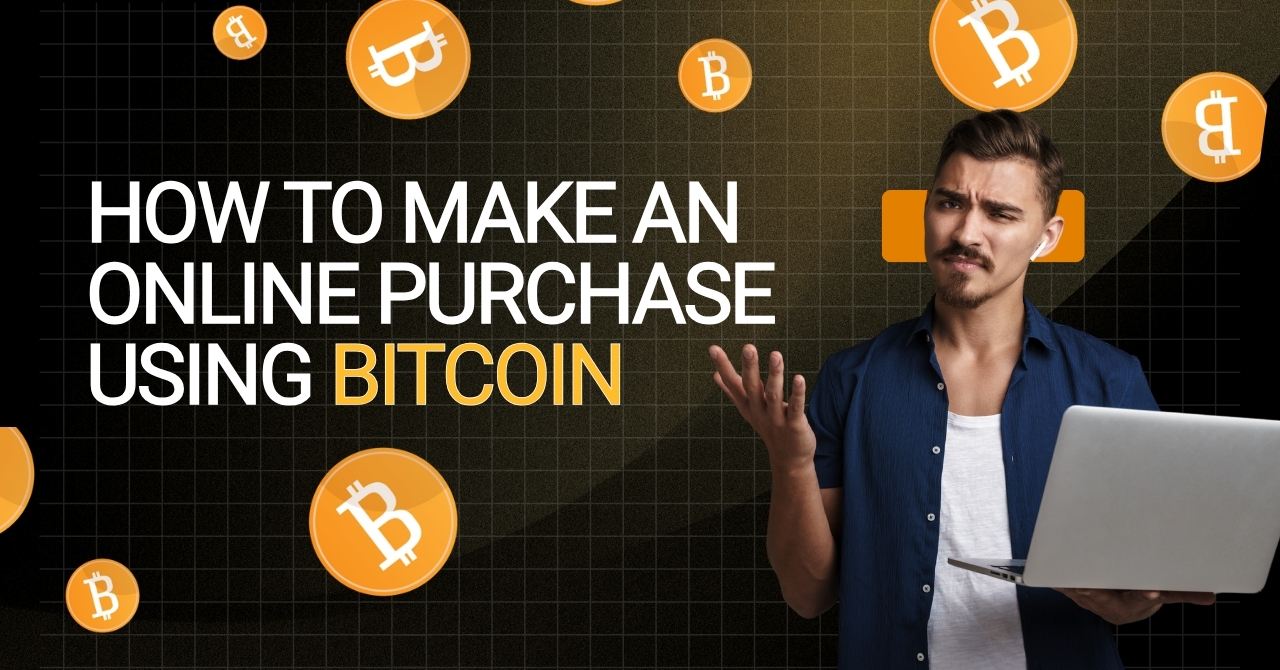In 2025, as digital assets continue to disrupt traditional finance, understanding what network Bitcoin runs on is more than just trivia; it’s a gateway to smarter investing. This article breaks down Bitcoin’s infrastructure from a trader’s lens, helping you grasp not just how it works, but how to use it to your advantage.
1. What is Bitcoin? How does Bitcoin work?
When I first encountered Bitcoin, what struck me most wasn’t its price; it was the idea. An open monetary network that doesn’t rely on banks or governments, yet functions securely and globally? That’s not just innovation, it’s a revolution in finance. It led me to ask a foundational question early on: what network is Bitcoin on, and how does it enable such a system to operate without centralized control?

Bitcoin is a decentralized digital currency that operates on a peer-to-peer basis. It doesn’t rely on intermediaries like traditional banking systems. Instead, it uses a distributed ledger technology called the blockchain to validate and record all transactions.
Here’s how it works in practice:
- Anyone can participate. Once you install a Bitcoin wallet on your phone or desktop, it generates your first Bitcoin address. These addresses act like your personal bank account on the Bitcoin network, only they’re pseudonymous and you can generate multiple ones, for privacy.
- Transactions are powered by cryptographic principles. Your wallet signs transactions using a private key, a cryptographic proof that you’re the rightful owner of the Bitcoin being spent. This ensures that only you can authorize a transaction from your wallet.
- All transactions are broadcast to a network of over 10,000 nodes around the world. These nodes validate the data and ensure that no coins are double-spent or tampered with.
- Confirmations happen via mining. This process bundles transactions into “blocks” and adds them to the blockchain, a chain of blocks that serves as the shared, public ledger of every Bitcoin transaction.
So what makes this infrastructure so valuable to traders, investors, and technologists alike?
It’s simple: trust without intermediaries. Whether you’re trading forex, transferring funds, or storing wealth, Bitcoin’s architecture provides a globally verifiable and censorship-resistant platform for economic activity.
2. What network is Bitcoin on? Everything you need to know about the Bitcoin network
Let’s address the central question: What network is Bitcoin on?
Bitcoin runs on the Bitcoin network, which is a decentralized peer-to-peer (P2P) network of computers spread globally. This is not just some internet protocol, this is a living, breathing infrastructure maintained by thousands of independent machines.
More precisely, the Bitcoin network uses the Bitcoin blockchain, a public, distributed ledger that records every transaction ever made in Bitcoin’s history. Unlike centralized networks, where control resides with a company or authority.
The Bitcoin network is run by “nodes”. “What is a node on the Bitcoin network?” – Each node is a computer running the Bitcoin software, validating transactions, and keeping the blockchain in sync.
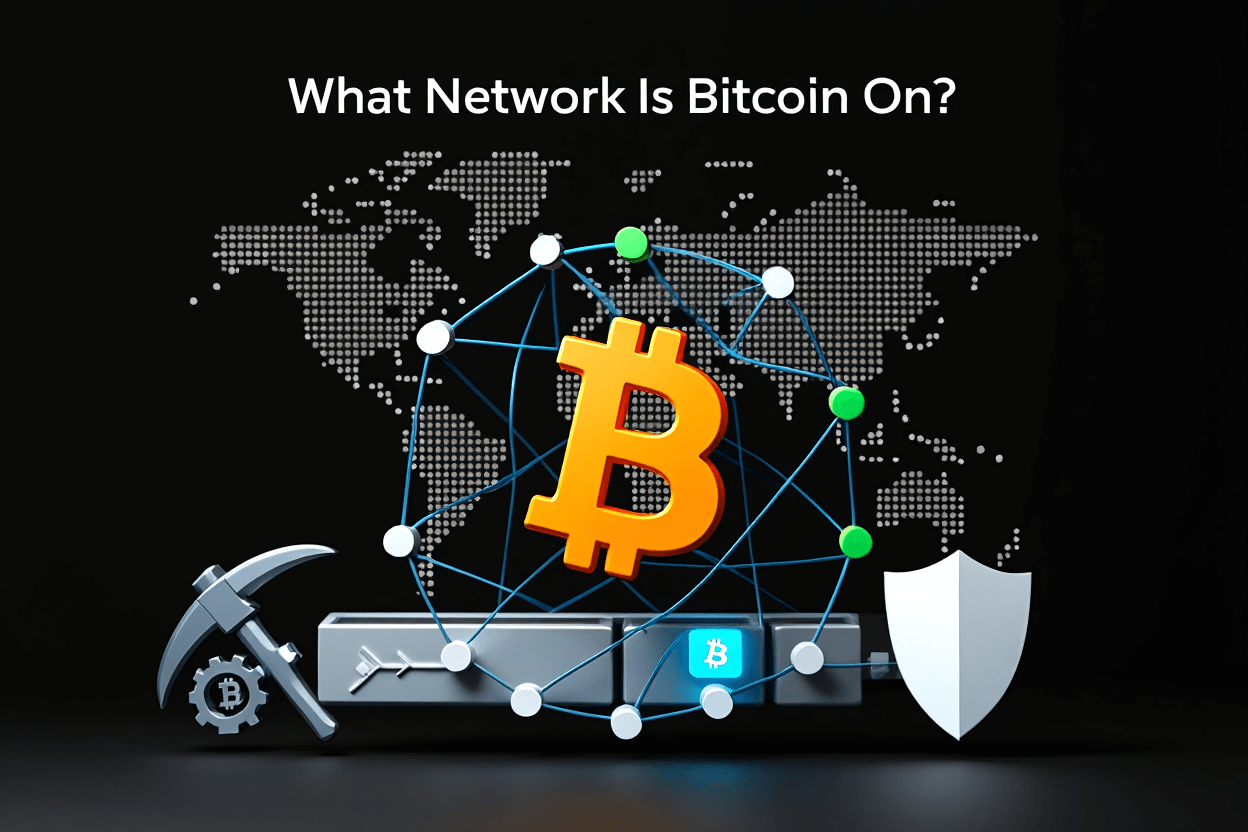
What makes the Bitcoin network different?
- Open Participation: Anyone can become a node. All you need is an internet connection and a Bitcoin client (like Bitcoin Core).
- Peer-to-Peer Messaging: Nodes “talk” to each other by relaying information about new transactions and blocks. This constant communication ensures the network stays updated and aligned.
- Censorship Resistance: Because no single entity controls the network, Bitcoin is virtually immune to being shut down or censored by governments or institutions.
- Functional Immutability: Once a transaction is added to the blockchain, it’s permanent. There’s no reversing it. This immutability adds a powerful layer of integrity.
In short, Bitcoin is on its own network, the Bitcoin Network. It’s not hosted by AWS or running on someone else’s servers. It is sovereign and self-reliant.
So, when you ask “what network does Bitcoin use?”, the precise answer is: Bitcoin uses the Bitcoin blockchain network, secured by miners, validated by nodes, and designed to run autonomously without needing third-party trust.
See more related articles:
- How Bitcoin Works for Beginners: A Simple Explanation for Everyone
- What is Bitcoin trading? A beginner’s guide
- What is Bitcoin trading for? Key purposes explained
3. 5 key features of the Bitcoin network
To fully appreciate why the Bitcoin network is critical for modern investors, especially those exploring forex or crypto, you need to understand its core attributes. Understanding these pillars also helps answer the key question: what network is Bitcoin on, and why does it matter for your portfolio? Here are the five pillars:
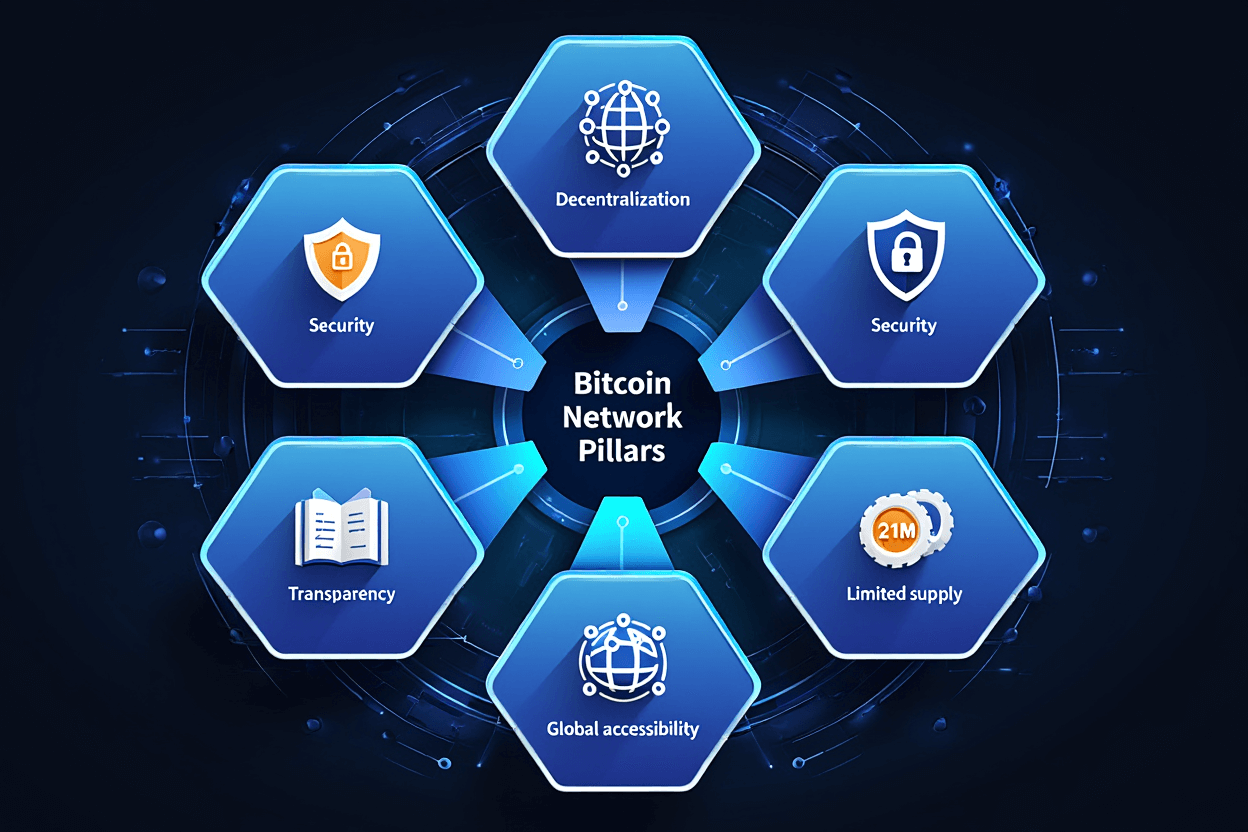
3.1. Decentralization
Bitcoin has no central authority. Its thousands of independent nodes operate around the globe, forming a system that resists single points of failure and censorship attempts.
This decentralization means you don’t need to trust a middleman. And that’s powerful, especially in regions where financial systems are fragile or tightly controlled.
3.2. Security
Security in Bitcoin isn’t just a feature, it’s a principle. Transactions are secured using public-private key cryptography, and miners use a proof-of-work (PoW) consensus mechanism to confirm blocks.
This process makes fraudulent transactions mathematically infeasible. It would take unimaginable amounts of computing power to override the ledger.
3.3. Transparency
Every transaction is stored on a public ledger that anyone can audit. While identities remain pseudonymous, the flow of funds is completely visible.
As a trader, this transparency means you can verify activity on the network yourself. You’re not relying on trust, you’re relying on code and consensus.
3.4. Limited supply
Bitcoin’s supply is capped at 21 million coins. This scarcity gives it properties similar to gold and makes it resistant to inflation.
For long-term investors, this characteristic is vital. Unlike fiat currencies that central banks can inflate at will, Bitcoin follows a fixed issuance schedule, making it a compelling hedge. This fixed schedule is enforced at the protocol level, helping to answer what network is Bitcoin on and why it remains trustless and tamper-resistant.
3.5. Global accessibility
Bitcoin is borderless. As long as you have an internet connection, you can use it. No banks. No identity verification (beyond wallet creation). Just code.
And thanks to Layer-2 scaling solutions like the Lightning Network, Bitcoin now supports instant, low-cost payments worldwide, solving the speed and fee challenges of its early days.
4. How can I participate in the Bitcoin network?
One of the most powerful truths about the Bitcoin network is that it remains open to everyone. You don’t need a finance degree, special license, or permission from a central bank to become a participant. All you need is curiosity, and a few practical steps.
So, how do you get started?
From our hands-on experience and research in this space, we’ve found the most direct path to participation is becoming a node. This means running a piece of software known as a Bitcoin client. Once installed, the client connects your device to the peer-to-peer Bitcoin network, turning your machine into an active part of the decentralized system.

Here’s what happens:
- The software begins downloading the full blockchain, which is essentially a complete record of all verified Bitcoin transactions since 2009.
- As your node syncs with others, it begins receiving and broadcasting new transactions across the network.
- You don’t need to mine Bitcoin or have a huge computing setup, just running a node makes you part of the ecosystem.
If you want to allow other nodes to connect to your device directly, you might need to tweak your router settings slightly. This step also helps you engage more directly with what network is Bitcoin on in practice. This minor adjustment completes your transition from a passive observer to an active node on the Bitcoin network.
Through this role, you help preserve the integrity and decentralization of the blockchain, an essential part of why Bitcoin is trusted globally today. And as someone exploring forex or digital asset investing, becoming a node provides firsthand experience with the very infrastructure supporting Bitcoin’s value.
5. Types of Bitcoin networks every investor should know
When people ask what network is Bitcoin on? They often refer to mainnet, the live Bitcoin blockchain where real transactions occur. But the Bitcoin ecosystem includes multiple networks that serve specific use cases, especially for developers and testers.
Here’s a simple breakdown:
| Network | Purpose | Monetary Value | Address Prefixes | Who Should Use It? |
| Mainnet | Real Bitcoin blockchain used for actual BTC transactions | Yes | 1, 3, bc1 | Investors, traders, general users |
| Testnet | Simulates Bitcoin environment for testing without real value | No | 2, m, n, tb1 | Developers testing apps or wallets |
| Signet | Controlled testing with digital signatures (not PoW) | No | Variable | Advanced testing under strict controls |
| Regtest | Private local network for instant block creation and testing | No | User-defined | Developers needing full control for private testing |
Each of these networks operates independently. Importantly, Bitcoin cannot be transferred between these networks. For example, sending real BTC (mainnet) to a testnet address results in a permanent loss of those coins.
Read more:
- Guide to Buying Bitcoin and Cryptocurrency Investment in Vietnam 2025
- What is the best way to buy Bitcoins? Top 4 methods for investors
6. FAQs: Common questions when searching for what network is Bitcoin on
6.1. Is Bitcoin on the Ethereum network?
No, Bitcoin runs on its own native blockchain. It’s the Bitcoin Network. Ethereum and Bitcoin are separate networks with different consensus mechanisms. However, wrapped versions of Bitcoin (like WBTC) exist on Ethereum for DeFi use, but these are synthetic tokens, not actual BTC.
6.2. What network do you send Bitcoin on?
You send Bitcoin using the Bitcoin Network (on-chain) or via the Lightning Network (Layer-2). On-chain sends are secure but slower; Lightning offers near-instant, low-fee payments. Your wallet will usually let you pick which network to use, depending on speed or cost preferences.
6.3. What network is Bitcoin Cash on?
Bitcoin Cash (BCH) operates on its own blockchain, forked from Bitcoin in 2017. It’s no longer part of the original Bitcoin network. BCH itself has also split into networks like Bitcoin SV and Bitcoin ABC, each with unique rules and communities.
6.4. Can I run my own Bitcoin network node?
Absolutely. Anyone can run a Bitcoin node by downloading a client like Bitcoin Core. No special hardware is needed. Your node helps verify transactions and strengthens the network’s decentralization, making you a direct part of the Bitcoin ecosystem.
6.5. Does Bitcoin use proof of stake or proof of work?
Bitcoin uses Proof of Work (PoW), a consensus mechanism that secures the network by requiring miners to solve complex mathematical puzzles. Unlike Proof of Stake, PoW relies on computing power, not coin ownership, to validate transactions and secure the blockchain.
7. Conclusion
Now that you’ve explored what network is Bitcoin on, you understand that Bitcoin is not just a currency, it’s an open infrastructure that anyone can join, secure, and build on. You’ve learned how to become a node, the distinctions between mainnet and other test networks, and how each plays a unique role in maintaining Bitcoin’s reliability.
For investors, whether navigating forex, crypto, or broader digital asset markets, this knowledge is more than technical trivia. It’s foundational. Understanding what blockchain network Bitcoin is on, or how nodes maintain the ledger, gives you a strategic edge.
Explore more expert resources in the Bitcoins section on the VN-US Trade website to elevate your crypto investing strategy. The future of finance is already here, and by understanding what network is Bitcoin on, you’re ready to lead it.

